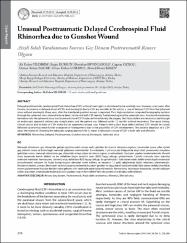Unusual posttraumatic delayed cerebrospinal fluid rhinorrhea due to gunshot wound

Göster/
Erişim
info:eu-repo/semantics/openAccessTarih
2014Yazar
Yıldırım, Ali ErdemDursun, Engin
Dıivanlıoğlu, Denizhan
Özdöl, Çağatay
Nacar, Osman Arıkan
Çorapcı, Övünç Erdem
Belen, Ahmed Deniz
Üst veri
Tüm öğe kaydını gösterKünye
Yıldırım A. Dursun, E., Divanlıoğlu D., Özdöl, Ç., Nacar, OA., Çorapcı, OE., Belen, AD. (2014). Unusual Posttraumatic Delayed Cerebrospinal Fluid Rhinorrhea due to Gunshot Wound. Turkish Neurosurgery, 24(2), 276 - 280.Özet
Menenjit olmaksızın geç dönemde gelişen posttravmatik rinore nadir görülen bir durum olmasına rağmen, travmadan sonra yıllar içinde geç dönem rinore ve buna bağlı menenjit gelişmesi mümkündür. Bu makalede, 3 yıl önce yüz bölgesinde ateşli silah yaralanması meydana geldikten sonra, menenjit olmaksızın geç dönemde ortaya çıkan bir rinore olgusu sunulmaktadır. Hastanın yapılan incelemelerinde sfenoid sinüs tavanında kemik defekti ve bu defektten beyin omurilik sıvısı (BOS) kaçışı olduğu gösterilmiştir. Cerrahi sırasında sinüs içerisine araknoid membran herniasyonu izlenmiş olup, defektten BOS kaçağı olduğu da görülmüştür. Kafa tabanındaki defekt endoskopik endonazal transsfenoidal yaklaşım ile hiçbir komplikasyon olmadan tamir edilmiş ve hastanın 12 aylık takiplerinde hiçbir rekürrens izlenmemiştir. Rinorenin nedeni, zamanı, klinik seyri ve lokalizasyonu nedeniyle bu nadir görülen bir olgu olarak kabul edilebilir. Kafa tabanı defekti olan fakat rinore gözlenmeyen hastalar ileride rinore gelişme riski nedeniyle yakın takip edilmelidir. Rinore tanısı kesinleşen hastalarda, cerrahi yaklaşım yolları arasından, endoskopik endonazal yolla yapılan onarım hem efektif hem de güvenli olarak kabul edilmektedir. Delayed posttraumatic cerebrospinal fluid rhinorrhea (CSFr) without meningitis is considered to be relatively rare. However, even years after trauma, recurrence or delayed onset of CSFr and meningitis due to CSFr are possible. In this article, a case of delayed CSFr from the sphenoid sinus without meningitis three years after the transfacial gunshot wound is reported. Plain high-resolution computed tomography sections through the sphenoid sinus showed a bone defect at the roof with CSF-density fluid extending into the sphenoid sinus. Arachnoid membrane herniation into the sphenoid sinus was found and site of CSF fistula confirmed during the surgery. Skull base defect was reconstructed through an endoscopic approach without any complications and the patient was followed up for 12 months without recurrence. The cause, timing, clinical course and location of CSFr make this an apparently unique case. Patients with a skull base defect without CSFr should be closely followed up and may need further evaluation or management due to the possibility of CSFr development. The positive diagnosis of a CSFr raises the matter of choosing the adequate surgical approach for its repair. Endoscopic closure of CSFr is both safe and effective.

















